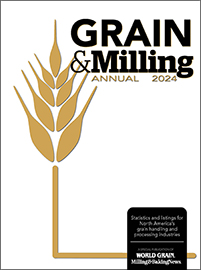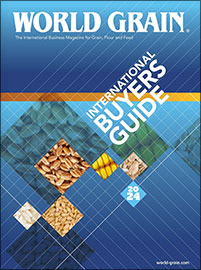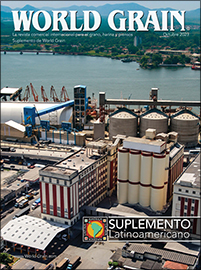In this article, parameters for magnet selection for three mill sizes will be evaluated to show how capacity, product density, spouting angles and entry into a gravity spout influence magnet design.
Magnet Design
Magnet design consists of two major design issues. The first is the circuit design followed by the design style of the magnet to be utilized. The circuit design of the magnet may include the use of ferrite (commonly known as cereamic), rare earth magnets or a combination or hybrid to achieve desired circuit field strength and greater captured metals retention. In addition, the circuit design may include selection of radial, axial or a combination of pole design to achieve desired field circuit. The circuit design must address the material targeted for removal. For example, in grain receiving areas and perhaps entry into grain cleaning operations the ferrous material may include larger nuts, bolts, washers and equipment pieces associated with grain production, storage and handling.
In the case of mill feed and flour, the type of ferrous material anticipated for removal will be much smaller and include screws, staples, nails, washers and metal shavings from equipment wear. Ferrous material, whether from raw material or your own process, are to be excluded from entry into the processing system as well as finished product from both an operational and finished product point of view.
Style depends on application as well as customer needs, which may include cleaning plates, retention air-gaps, and wear surface replacement. Because of a cleaning plate requirement, the addition of a 3.2-millimeter-thick stainless steel at the magnet’s surface results in a 40% holding strength loss. The loss in holding strength must be accounted for in the final magnet design and may lead to higher magnet cost.
In some cases, where magnetic forms of iron may be used in flour fortification, the design may consider a 1.6 to 3.2-millimeter buildup of iron powder on the magnet’s surface that will continually slough off yet allow for ferrous metal contaminate pick up due to its higher magnetic attraction. A typical particle size analysis for reduced iron has a d(0.1), d(0.50) and d(0.9) of 21, 27 and 61 micrometers(microns), respectively, which is very small.
Mill Capacity and Stock Properties
Density for wheat, flour and feed provided in Figure 2 (below) shows at least a 3-4 reduction in product density from wheat to feed. Moisture content of the product moving across the magnet also may impact design as one could imagine the additional magnetic pull required to pull a ferrous contaminate through freshly tempered wheat compared to dry wheat.
Spouting Parameters
Product speed and location is determined by the spouting angle and method of entry into the spout. More shallow angles and slower product velocity may allow for somewhat reduced surface gauss design requirement. As spouting angle increases above 60 degrees, for example, product may move away from the bottom of the spout where product scattering effectively increases product depth, increasing the need for greater flux density away from the magnet’s surface if using a plate style magnet. It may be appropriate to consider a dual plate magnet design for complete coverage of the product in the spout. Drawer type magnets are typcially employed in vertical spout applications.
Increased product velocity resulting from positioning a magnet farther away from the point of entry or having a more dynamic entry such as at the discharge of a bucket elevator rather than a drop from a screw conveyor may also increase demand for surface gauss in magnet design.
For spouting installed on a 45-degree slope handling whole dry grain, the grain entering from a bucket elevator is reported to be traveling at a speed of 188 meters per minute. At 6.1 meters down the spout, the velocity doubles to approximately 377 meters per minute. The holding force required increases farther downstream from the point of entry and would likely increase magnet cost. The cost may be worthwhile if the magnet is positioned where it may be monitored and cleaned without the use of a ladder.
Product Presentation
One design characteristic often overlooked in magnet design is the presentation of the product to the magnetic field. Several examples come to mind in this regard. Often, when we discuss flow rate there is a mind’s eye image created that reflects a steady flow of uniform product moving across the magnetic surface. The instantaneous reality of a screw conveyor, bucket elevator or batching system discharging may result in anything but flow uniformity and in the extra bed depth may hide the contaminant outside the pull field of the magnet resulting in system failure.
Discharge of equipment may also result in varying load across the magnet where, on average, the design may facilitate separation, but areas where velocity is increased due to lower loading or depth increased the ability to pull and hold may be compromised. Both plate magnets and drawer type magnets are typically designed with the expectation of uniform flow, product density and moisture. Satisfactory performance of a properly designed magnet cannot be achieved without consideration of product presentation.
Summary
No matter how well designed, the magnet must be properly isolated, sealed and cleaned to maintain desired performance criteria. The laws of physics that applied to magnets and magnetic fields never change. Performance of a magnet may change because of uncontrolled application changes. It is our responsibility to work with magnet suppliers to properly identify the controlled variables or design parameters and anticipate uncontrolled variables that may impact performance. Understanding the attributes of product being handled, targeted material to be removed and magnet installation site increases our chances of developing a successful magnet control program.








